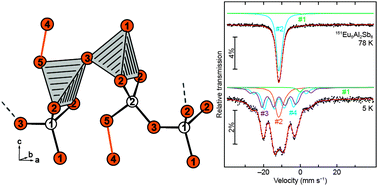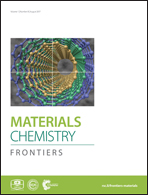Synthesis, crystal and electronic structures, physical properties and 121Sb and 151Eu Mössbauer spectroscopy of the alumo-antimonide Zintl-phase Eu5Al2Sb6†
Abstract
Eu5Al2Sb6 was synthesized from the elements in niobium ampoules. It crystallizes in the orthorhombic crystal system (a = 1027.55(7), b = 1200.28(6), c = 1324.22(7) pm) with space group Pnma (no. 62), isostructural to Sr5Al2Sb6, and can be described as a Zintl phase. The Al atoms are tetrahedrally surrounded by Sb atoms, forming branched strands. Besides Sb3− anions, antimony Sb24− dumbbells can also be found in the crystal structure. Eu5Al2Sb6 [≡(Eu2+)5(Al3+)2(Sb3−)4(Sb24−)] exhibits three magnetic ordering phenomena at T1 = 12.3(1), T2 = 10.6(1) and T3 = 3.0(1) K, obtained by heat capacity measurements. While T3 is of antiferromagnetic nature, T1 and T2 correspond to canted antiferromagnetic transitions. Resistivity investigations indicate that the title compound is a semiconductor, in line with the band structure calculations. Spin exchange parameters, calculated using mapping analysis, confirm that the magnetic phase transition at TN = 3.5(1) is associated with the ordering of Eu1 atoms. The divalent character has been confirmed by 151Eu Mössbauer spectroscopic studies. Measurements conducted at 5 K show a hyperfine field splitting for two of the three Eu sites, underlining the magnetic data. Additionally, 121Sb Mössbauer spectroscopic studies have been conducted on Eu5Al2Sb6 and isostructural Sr5Al2Sb6.



 Please wait while we load your content...
Please wait while we load your content...